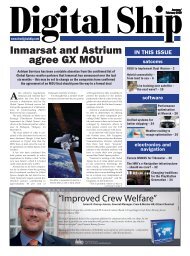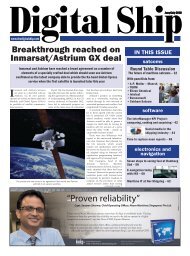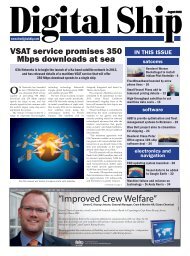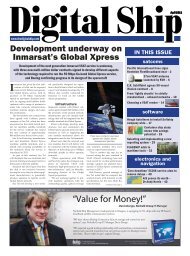Digital Ship
Digital Ship
Digital Ship
You also want an ePaper? Increase the reach of your titles
YUMPU automatically turns print PDFs into web optimized ePapers that Google loves.
SATCOMSSpliethoff’s ships will be installed with the Connector by Radio Holland VSAT service (right), with FleetBroadband (left) as a back-upinto separate sub networks (VLANs) forbusiness, crew and voice, as well as a sensorLAN,” Mr Van de Venne explained.“A central firewall is used to managethe interconnections. Wireless access is, inprinciple, not used, because it is more difficultto manage, more difficult to arrangecoverage and may interfere with otherradio signals.”“As the crew network is completely separatedfrom the business network whatthey do on their private laptops is theirown responsibility. For the business network,we have the challenge of keeping theanti-virus and anti-malware up to date.”The availability of crew communications,in particular, was a major influenceon this network design, as Mr Van deVenne recalls.“The business usage of voice and datawas not our main reason for upgrade, wecould have continued well with basic e-mail functionality, which we could alsouse for synchronising databases,” he said.“It was the crew welfare side combinedwith speeding up business communicationthat were the primary reasons forupgrading. We used to dial-in only onceor twice per day to exchange messages.”“It is important to provide good facilitiesfor crew members. Providing ‘always on’internet will hopefully keep them enthusiasticabout life at sea and especially to continueworking for the Spliethoff Group.”As such Spliethoff is providing, on itsVSAT enabled ships, online internet accessto its crews without any traffic restrictions.“(Achieving this, and doing it) at thelowest cost was the first goal,” said MrVan de Venne. “These young cadets thathave grown up with internet would beshocked if they didn’t have any internetaccess at all on board. New times call fornew ways.”“An important aspect of this is defininga clear policy for use of onboard ICT systemsthough. In some countries the carrieris held responsible for what crew has ontheir own laptops. Also, we cannot allowdistractions on the bridge or engine room.”Spliethoff has chosen not to add anyoptimisation and compression systems atthis time due to what it sees as the extracost and extra maintenance that would beinvolved. The company believes that thereis no immediate need for such systems atpresent, though conceded that this maychange in the future.Another issue for the company to contendwith in the management of its communicationsis what, and how, to chargethe crew for private use of these new services,which have been, after all, primarilyinstalled for their benefit.“In the old days, we would simply forwardthe Inmarsat phone details to the shipdaily so that private calls could be chargedto the crew,” notes Mr Van de Venne.“Now that is much more difficult. Justthink about MSN phone calls alone. If youdecide to charge based on usage, you needto install additional equipment for itwhich also brings additional costs.”“As a rule of thumb you may say thatwhatever you give as bandwidth will betaken by the vessels. The charged voiceminutes could appear to remain about thesame, but of course a lot remains hiddenbecause the crew is also using VoIP callsvia MSN, or other methods.”Remote accessSpliethoff’s VSAT-enabled vessels are connectedto shore offices via a VPN tunnel,which has helped the company to addadditional remote access capabilities to itsIT infrastructure.“This allows us to monitor if they areonline via VSAT and makes it easier toaccess the business PCs on board forremote support,” notes Mr Van de Venne.“We are already working with remotesupport on ships’ cranes. However,because of the less predictable connectionand high latency, we are not pushing onlineapplications to the office.”“A clear challenge is keeping the virusand malware control up to date. But forbusiness applications we can rely on databasesynchronisation via e-mail, and donot really need a direct connection.”While this remote access has allowedSpliethoff’s IT staff to more effectivelymanage onboard systems, Mr Van deVenne is still not completely satisfied withthe remote connectivity capabilities currentlyavailable to shipping companies,and believes there is a lot of room forimprovement.“It would be nice if suppliers would gettogether and decide on a standard way tomonitor and support their equipment,” hetold us.“Suppliers have a tendency to go for aVPN connection for themselves, while weas a carrier wish to be able to have closecontrol over how and when they getaccess. So we do not wish to give themComtech and KNS integrate technologiesdirect access via the satellite.”“We would also consider things liketelemedicine and remote video, for technicalmaintenance support, as potentialapplications for the future.”However, in general Mr Van de Vennefeels that, for the moment at least, onlineapplications, such as those with a directlog-in to office applications, are not realisticin the maritime environment.“Due to the high latency, which is truefor all satellite connections not only VSAT,and potentially unreliable connectionswhere you might have ships’ cranesobstructing the satellites or weather influence,there is obviously a big differencewhen compared to landlines,” he said.Despite these limitations Mr Van deVenne is however fully convinced thatbroadband communication will be theway of the future in the shipping industry,and that the appetite for bandwidth willonly continue to increase – particularly onthe crew side.“I think it is inevitable,” he said.“You only have to look at your situationat home, where in most cases you’ll have atleast 8 Mbps – and then we ask people to goto sea with nothing, or 0.032 Mbps?” DSwww.comtechefdata.comwww.kns-kr.comComtech EF Data Corporation, a providerof communication solutions, and Koreabased KNS, specialising in marine antennasystems for satellite communications,have announced the integration of theSuperTrack Series of marine stabilisedantenna systems and the RoamingOceanic Satellite Server (ROSS) OpenAntenna Management (ROAM) protocol.The integration aims to enable theSuperTrack antenna systems on maritimevessels to roam across multiple satellitebeams, maintaining connectivity whilemoving through different satellite footprintsand enhancing communicationcapabilities at sea.The ROAM protocol offers a commonmanagement interface for Comtech’sROSS and third-party Antenna ControlUnits (ACUs) by providing a base set ofASCII character commands, information,interfaces and status queries.ROSS is a location server that works inconjunction with Comtech’s VipersatManagement System to facilitate onthe-movesatellite communications foroceanic vessels.It enables remote modems to interfacewith stabilised, auto-tracking antennas,maintaining connectivity as vessels movethrough footprints of different satellites.Vessel position data, satellite signaland management status are monitoredto determine when satellite handoffis necessary.The ROAM protocol provides thebasic parameters required to globallyroam across multiple satellite beams aswell as uniformity in the implementationof third-party antenna manufacturers’interfaces, while catering for unique characteristicsand proprietary techniques ofdifferent manufacturers."The interoperability of ROAM andROSS with SuperTrack VSATs willenable maritime operators to have maximumbandwidth efficiencies and roamingcapabilities for their satellite-basedcommunications at sea," says DanielEnns, senior vice president strategic marketingand business development forComtech EF Data.KNS’s SuperTrack Series of VSAT stabilisedantennas are built on 3-Axis platformsthat enable them to gyrate along theX, Y, and Z axes and move 90 degreesper second.<strong>Digital</strong> <strong>Ship</strong> June/July 2011 page 16








